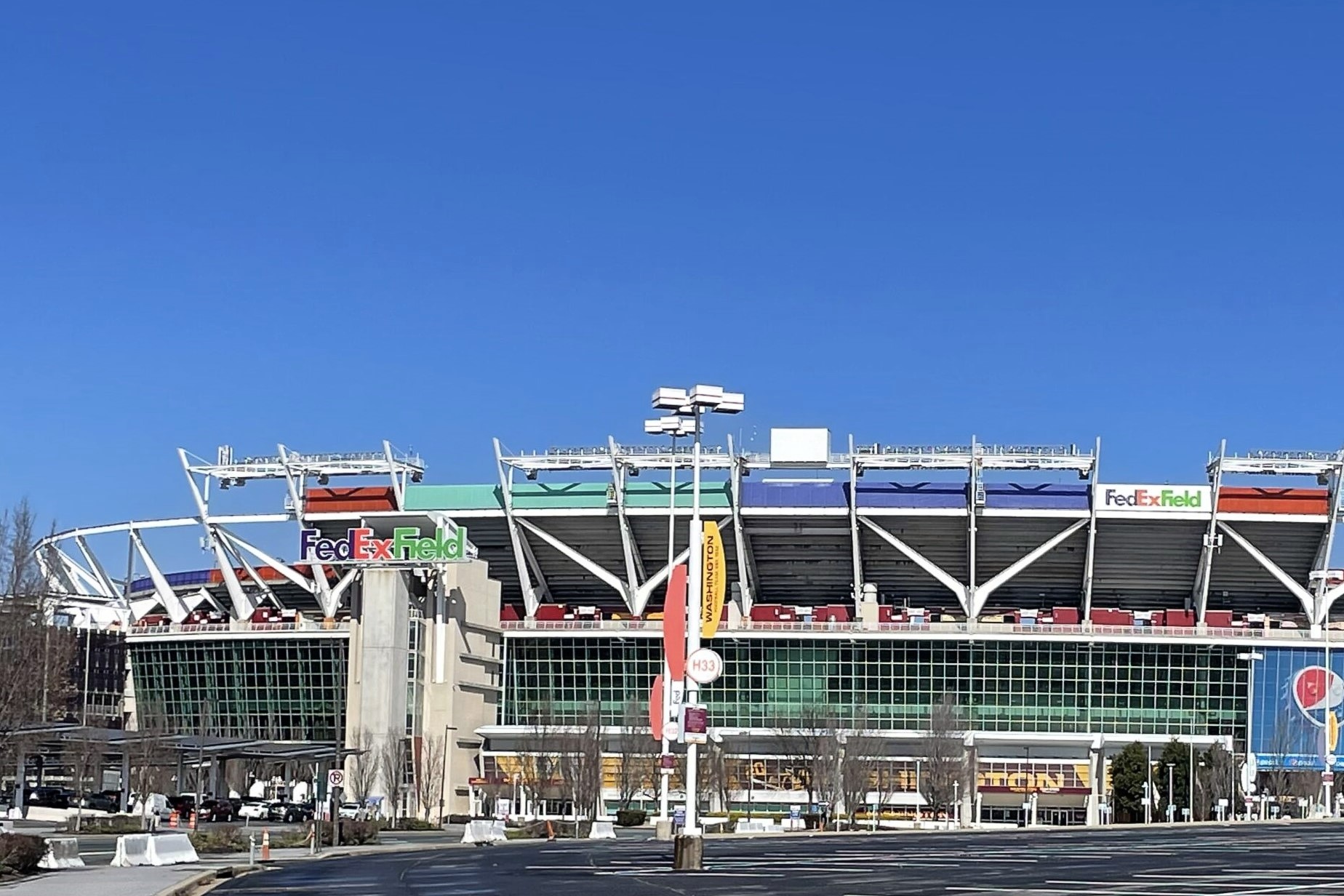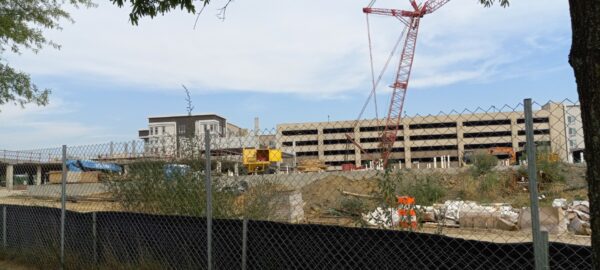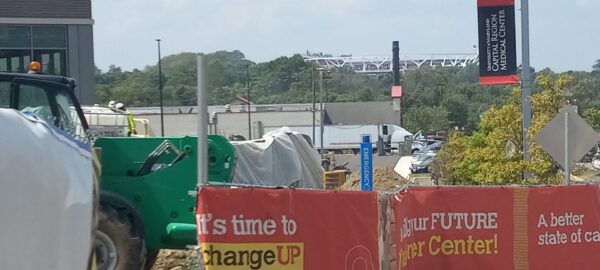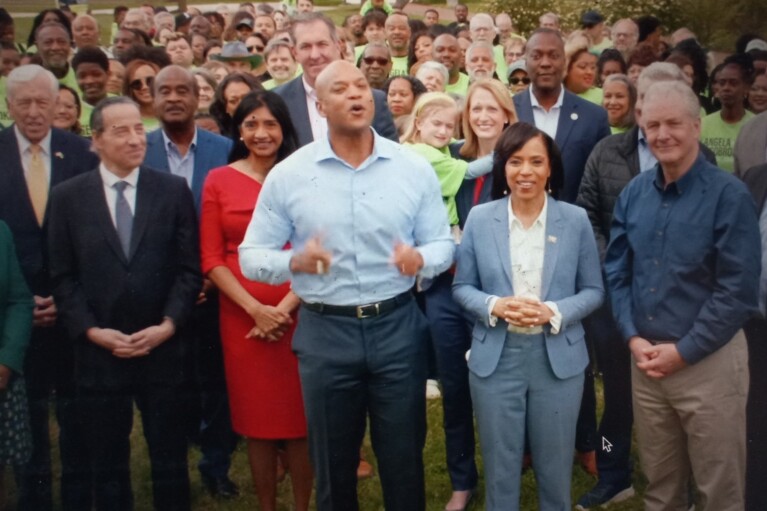
Washington Commanders fans are psyched for the opening game of the football season Sunday at FedEx Field in Landover.
They may not agree on whether the team will be competitive this year. But there is undeniably a new vibe in the fan base, thanks to the recent departure of one of the most detested owners in professional sports, Daniel Snyder.
In the neighborhoods surrounding FedEx Field, there’s a new vibe as well. After years of neglect — by the team, and to a lesser extent the state and local governments — the communities in what is known as the Blue Line Corridor of Prince George’s County are poised to benefit from a $400 million state investment to help redevelop properties near four Metrorail stations. The end result, if all goes as planned, could be nothing less than transformational.
“In the next several months you’re going to see a lot of shovels going into the ground,” County Executive Angela Alsobrooks (D) said in a recent interview.
The Prince George’s government in 2020 developed a master plan for the area to bring an array of development to land that is mostly owned by the county or by other public entities like the Washington Metropolitan Area Transit Authority, which operates Metro. Put simply, the county wants to reimagine communities along Central Avenue into a vibrant urban area. Now commuters from the farther reaches of Prince George’s, Anne Arundel County and Southern Maryland mostly zoom through that area on the suburban six-lane highway to get to Washington, D.C.
“The vision for it is we would be bringing these projects for communities that previously had seen nothing,” Alsobrooks said. “Seat Pleasant, Capitol Heights, areas that hadn’t seen many amenities. It’s going to totally transform this whole area.”
But as the Commanders kick off their new season, a major unknown — with profound economic implications for the entire DMV region — is where they plan to build their next long-term home. And as officials in Maryland, Virginia and D.C. scramble for the privilege — and undeniable challenges — of becoming the site for the envisioned new Commanders stadium, it’s not entirely clear whether the development of the Blue Line Corridor ought to be seen as part of the state’s bid to keep the Commanders in Prince George’s County.
“I’m a little confused myself,” said Lloyd Blackwell, a lifelong resident of the Blue Line Corridor who is working with a regional development company to build a mixed-used development on property he owns near Addison Road in Capitol Heights.
The team is committed to play at FedEx Field through 2027, and the new owners, led by investor Josh Harris, have sunk some $40 million into the stadium recently to improve the “fan experience.” The team and the State Highway Administration are also collaborating on plans to improve access to and from the stadium on game days, to ease choking congestion on the Capital Beltway and nearby roads.
But the 2027 deadline is a bit of a myth: News reports often say the team’s lease expires then. That’s actually when the team can first contemplate departing; to get government assistance decades ago to improve roads and other infrastructure near the stadium, the team contractually agreed to stay until at least 2027.
The team owns the stadium, and 190 acres around it, including parking lots. So there is no expiring lease and no one is demanding that the Commanders leave; the imperative for a new stadium comes from the team itself (The Athletic, a sports news website, recently rated FedEx Field the worst stadium in the NFL).
“I think the ownership team just spent $6 billion, largely in cash, to purchase the team. I don’t think they’re in a rush to spend over $2 billion to move the team,” said Del. Jazz S. Lewis (D-Prince George’s), whose district includes the Blue Line Corridor.
Undeniably, there will be a bidding war in the years ahead for the team’s desired new stadium. And it’s widely believed that the new ownership group — which includes D.C.-area natives like Harris and Mitchell Rales, along with sports and business icon Magic Johnson — may find the idea of building a new stadium in D.C., where the team had its glory years, irresistible — if it’s feasible.
But Gov. Wes Moore (D) says he’s determined to keep the team in Prince George’s County — provided it isn’t going to cost the state very much money. As a sign of his ardor for the team, he and Lt. Gov. Aruna Miller (D) traveled to the Commanders’ training facility in Ashburn, Va., last month, meeting with team officials, watching players practice, and shaking hands with very enthusiastic fans.
“When you see the energy out here today, when you see the energy of what we plan to do in the Blue Line Corridor in Prince George’s County, it’s a perfect marriage,” Moore told reporters assembled on the sidelines of the team’s main practice field that day.
The governor also suggested, in so many words, that he saw the $400 million the state has committed to the Blue Line Corridor as something of a downpayment on a new deal with the Commanders.
“We are not waiting, we are not delaying, we are not stalling,” he said. “We are making it clear that we are fully united behind the idea of keeping the Commanders in Prince George’s County.”
But is that the right way think about the money, and the improvements Prince George’s County leaders envision for the area?
“Governor Moore sees this as a down payment on the future, an investment that will help build the competitive economy Maryland wants to see in Prince George’s County,” the governor’s spokesperson, Carter Elliott IV, said Thursday.
The $400 million was committed during the 2022 General Assembly session, before Moore took office. It was a priority for county leaders like Alsobrooks and, in Annapolis, for an aggressive member of the House Appropriations Committee, Del. Ben Barnes (D-Prince George’s), who has since become the Appropriations chair.
Not coincidentally, the Appropriations Committee toured Prince George’s County on Thursday — which included a 90-minute briefing on the Blue Line revitalization, where lawmakers heard from county leaders, local activists and nonprofit community development entrepreneurs.
“Prince George’s County is already growing,” Angie Rogers, the county’s deputy chief administrative officer for economic development, told lawmakers. “The question is, are we going to be strategic about where and how it happens?”
Nothing in the state’s agreement with the county requires the millions of dollars heading Prince George’s way, secured by bonds issued by the Maryland Stadium Authority, to be used for a new stadium. It is merely meant to help county leaders realize their vision for a vibrant sports and entertainment district — which could conceivably be anchored by a new stadium — in the Blue Line Corridor. The corridor has already attracted $700 million in private investment, Alsobrooks said.
The county and the Maryland Stadium Authority have signed a memorandum of understanding on what the county’s goals and responsibilities for the area are and how local leaders intend to execute it. That document will be updated periodically, as various projects near the Metro stations (Capitol Heights, Addison Road, Morgan Boulevard and Downtown Largo) progress. These include:
- An amphitheater, with between 7,500 and 10,000 seats
- A central library and cultural center, with a charter school nearby
- A field house for scholastic sports
- A food and market hall, modeled after Union Market in D.C.
Earlier this week, the stadium authority signed off on a $10.5 million planning and design contract for the proposed Wayne K. Curry Civic Plaza, named for Prince George’s’ first Black county executive. The concept is to create a community space near government buildings in Largo, which would attract food trucks, craft vendors and festivals, replacing a more sterile suburban environment.
“The exciting news is that it’s happening, because Prince George’s County has never benefited from the stadium authority,” Alsobrooks said. “Can you believe we’ve never had the ability to have a project supported by the Maryland Stadium Authority?”
But the stadium authority’s participation in the project may be muddying the waters when it comes to public perception of any possible conversations state and local leaders are having with the Commanders. Unlike M&T Bank Stadium and Orioles Park at Camden Yards, both in Baltimore, the stadium authority had nothing to do with the construction of FedEx Field, which was privately funded and opened in 1997, though the state did pay for some road improvements to accommodate the stadium project.
“I don’t think people remember that, that we didn’t use state money for” FedEx Field, Alsobrooks said. “This is a new relationship.”

A view from the parking lot of the Downtown Largo Metro station, an area where new construction projects are springing up regularly. Photo by Josh Kurtz.
That’s a function of the stadium authority’s ever-expanding portfolio over the years. No longer confined to envisioning and building ballparks and arenas, the stadium authority in recent years has run school construction projects in Baltimore, is involved in discussions over the future of Pimlico Race Course and Laurel Park racetrack, has made improvements to the Roland E. Powell Convention Center in Ocean City, is involved in talks on whether a larger entertainment district is feasible near the downtown Baltimore stadiums, and has studied ways to improve distressed neighborhoods around the state.
The stadium authority has a web page dedicated to the Blue Line Corridor project. In addition to the county’s developments the agency is overseeing, the page lists “FedEx Field (Stadium Demolition)” as part of the scope of its work.
During this year’s General Assembly session, in a campaign spearheaded by Barnes, Prince George’s leaders fought for, and won, the right to appoint a member of the stadium authority board. That puts the county on par with Baltimore, which also has a seat on the stadium authority. Alsobrooks said the county would be announcing its pick “imminently.”
‘We don’t want to be held hostage by their decision’
While the county moves forward with its redevelopment of the Blue Line Corridor, it’s clear that the Commanders’ future plans loom large in the way state and county leaders envision the ultimate result — because it will look one way if the team stays and another way if the team goes.
“I think we’d be kind of short-sighted to just plow ahead without knowing what their intentions are,” Barnes said. “We still want to make sure this area is on an upward trajectory.”
Alsobrooks said the county won’t be “held hostage” by the Commanders.
“Obviously, the team making a decision to stay would be ideal,” she said. “We are very hopeful that they make the decision to stay. We think it’s better for them to make the investment along with us. But we don’t want to be held hostage by their decision. I felt the people who live there deserve not to be held hostage, to determine whether their community would have what they needed. We’re going to do that no matter what.”
Yet Alsobrooks also suggested that the Blue Line Corridor project would benefit greatly from a decision by the Commanders to rebuild near FedEx Field, and vice-versa. For all the prestige a stadium brings, FedEx has never sparked economic development in the neighborhood, and the team, under its previous ownership, never seemed interested in having those conversations. The stadium has caused innumerable traffic headaches for neighborhood residents, without the requisite fringe benefits. But with the county’s new vision for the Blue Line Corridor, state and local leaders believe a stadium could fit right in, the way many downtown ballparks and arenas across the country have led to thriving adjacent communities.

FedEx Field is in the distance at the construction site for a new cancer center in Largo. Photo by Josh Kurtz.
“Stadiums are not what they used to be,” Alsobrooks said. “Stadiums are not, you come and watch the game and then you leave. We’re talking about a whole sports and entertainment district, with a hotel, an amphitheater, with restaurants and other opportunities basically for people to be there seven days a week. So this would be a huge economic benefit.”
Alsobrooks said that when she was trying to persuade former Gov. Larry Hogan (R) to sign off on the $400 million in state funding, she cast the investment as a hedge against the possibility that the Commanders might eventually leave Prince George’s.
“I leaned hard on his heart-strings,” she recalled. “You’d leave people behind in this community with a great big hole in the ground?”
Hogan, who grew up in Prince George’s, eventually texted Alsobrooks: “I’m persuaded. You’re a great closer.”
During his visit to the Commanders’ training camp, Moore said there’s synergy between what happens in the stadium and what happens in the surrounding area.
“I think there is a shared vision that isn’t just about creating a winner on the field, but it’s about how we are creating winners off the field,” he said. “How we are thinking about driving entrepreneurial activity, creating new businesses, making sure there’s transportation assets that can easily [be accessed] for people to be able to go to the games and get back from the games. So we’ve already been having sensitive conversations, and I’m excited about where they are, where they’re going and that we have an exciting shared future together.”
The county has already seen improvements near the football stadium over the last few years, separate and distinct from whatever may happen with the team and the Blue Line redevelopments. The University of Maryland Capital Region Medical Center opened in Largo in 2021. The hospital also has broken ground on a regional cancer center next door, due to open next year.
The old Landover Mall is among three sites under consideration for a new FBI headquarters (another is in Greenbelt, the third in Springfield, Va.). And the Lerner family, powerful D.C.-area developers who own the Washington Nationals baseball team, have said they will put a large data center on the Landover Mall property if the federal government decides to move the FBI elsewhere.
The neighborhood has also received about $12 million in government funding to build a transportation “connector” alongside Central Avenue that would run from the D.C. line to Largo Town Center and would feature a hiker-biker trail. The project could ultimately include dedicated bus lanes as well.
Barnes said he sees growth of the Route 1 corridor in the Prince George’s communities of Hyattsville, Riverdale and College Park over the past decade as a possible model for what can occur along the Blue Line. Some development there was connected to an anchor institution like the University of Maryland, some was promoted by the county, and the rest grew organically.
“The Route 1 corridor was really developed as hubs, but now it’s effectively become one,” Barnes said.
‘Usually, the people who re-energize want to gentrify’
Who’s taking the lead when it comes to the state’s desire to keep the Commanders in Landover?
Moore has said several times over the past few weeks that he’s had multiple conversations with team owners and executives. Alsobrooks said she’s been talking with them regularly over the past few years, including Snyder when he owned the team (“He’s an interesting man,” she observed). Alsobrooks has also been talking to Magic Johnson — who has opened Starbucks franchises and movie theaters in Prince George’s — since before he became part of the ownership group.
“His goal has long been to go into underserved areas with investment,” she said.
Elliott, Moore’s spokesperson, said the governor is going to continue having “conversations on keeping the Commanders in Maryland with all government and community partners along with the Commanders organization.”
“This project is going to take a village to complete and Governor Moore plans to work with everyone to ensure the Commanders stay right where they belong in Prince George’s County,” Elliott said.
Some community leaders look at the all the activity with a combination of hope and trepidation. Asked during the House Appropriations Committee visit Thursday if the redevelopment has encountered community opposition, Jose Sousa, a county planner, replied, “I would call it spirited debate.”
Kyle Reeder, an activist who lives in Capitol Heights and has organized a rolling farmers’ market and other community initiatives in the neighborhood, said the economic development plans, however exciting, are weighted by history.
“I really want to see that growth shared with the communities that have been disenfranchised through the generations,” said Reeder, whose family has lived in that area since the 19th century. “It’s important that we create robust urban environments that allow the most people to get the most good.”
And, Reeder added, “I hope that $400 million [from the state] was just the first bite at the apple.”
Blackwell, who is developing the property on Addison Road, said longtime community residents are understandably wary of outsiders.
“It’s been a small, bedroom, suburban community for so long,” he said. “Now we have to re-energize. Usually, the people who re-energize want to gentrify.”
On the other hand, Blackwell said, the community has to change the narrative that it’s seedy and unsafe, in order to attract greater outside investment.
“We need someone to come in and say it’s not bad and tell the story,” he said.
Lewis, the state delegate, said he’s confident that the story can continue to unfold regardless of what the Washington Commanders eventually do.
“I get a little tired of hearing about the stadium and team,” he said. “We need to create the type of environment where they’ll want to stay. And if they leave, we want to create the type of environment that will allow another anchor to thrive there. We can’t lose sight of the fact that thousands of people live there.”
Bryan P. Sears contributed to this report.




 Creative Commons Attribution
Creative Commons Attribution